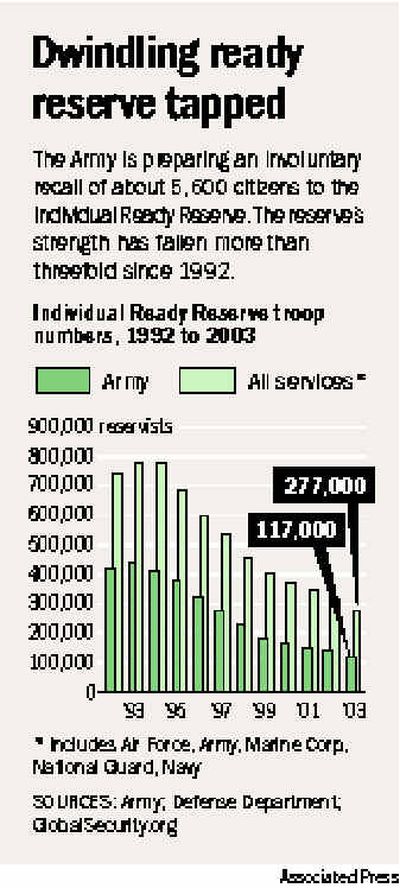Army to recall former soldiers to active duty

WASHINGTON – Digging deeper for help in Iraq and Afghanistan, the Army is recalling to active duty about 5,600 people who recently left the service and still have a reserve obligation.
In a new sign of the strain the insurgency in Iraq has put on the U.S. military, Army officials said Tuesday the involuntary callups will begin in July and run through December. It is the first sizable activation of the Individual Ready Reserve since the 1991 Gulf War, though several hundred people have voluntarily returned to service since the Sept. 11, 2001, terror attacks.
Unlike members of the National Guard and Reserve, individual reservists do not perform regularly scheduled training and receive no pay unless they are called up. The Army is targeting its recall at those who recently left the service and thus have the most up-to-date skills.
“This was inevitable when it became clear that we would have to maintain significant combat forces in Iraq for a period of years,” said Dan Goure, a military analyst at the Lexington Institute, a think tank.
The Army is pinpointing certain skills in short supply, like medical specialists, military police, engineers, transportation specialists and logistics experts. Those selected for recall will be given at least 30 days’ notice to report for training, an Army statement said.
The Army is so stretched for manpower that in April it broke a promise to some active-duty units, including the 1st Armored Division, that they would not have to serve more than 12 months in Iraq. It also has extended the tours of other units, including some in Afghanistan.
The men and women recalled from the Individual Ready Reserve will be assigned to Army Reserve and National Guard units that have been or soon will be mobilized for deployment to Iraq or Afghanistan, unless they successfully petition for exemption based on medical or other limitations.
Members of Congress were notified Tuesday and a formal Army announcement was scheduled for today.
Those in the Individual Ready Reserve are former enlisted soldiers and officers who have some nonactive-duty military service obligation remaining, under terms they signed when they signed on but who chose not to fulfill it in the Guard or Reserve.
The Pentagon had hoped to reduce its troop levels in Iraq to about 105,000 this spring, but because of increasingly effective and deadly resistance the level has risen to about 140,000.
Military officials have said they may need to stay at that level for at least another year or two, a commitment of forces that could not be maintained by the active force alone.
The Army frequently must integrate reservists with its active-duty forces, but it rarely has to reach into the Individual Ready Reserve. The Army has about 117,000 people in this category of reservist; the Navy has 64,000, the Marine Corps 58,000 and the Air Force 37,000.
The military has relied heavily on National Guard and Reserve soldiers in Iraq, in part because some essential specialties like military police are found mainly in the reserves rather than the active-duty force and partly because the mission has required more troops than planned.
Reserve troops make up at least one-third of the U.S. force in Iraq, and this month they have accounted for nearly half of all troops killed in combat.
Not until May did the Army begin looking in detail at the available pool of people.
At that point some Army recruiters caused a controversy when they contacted members of the Individual Ready Reserve and suggested they would wind up in Iraq unless they joined a Reserve or Guard unit. Some complained that they were being coerced to transfer into a Reserve unit.